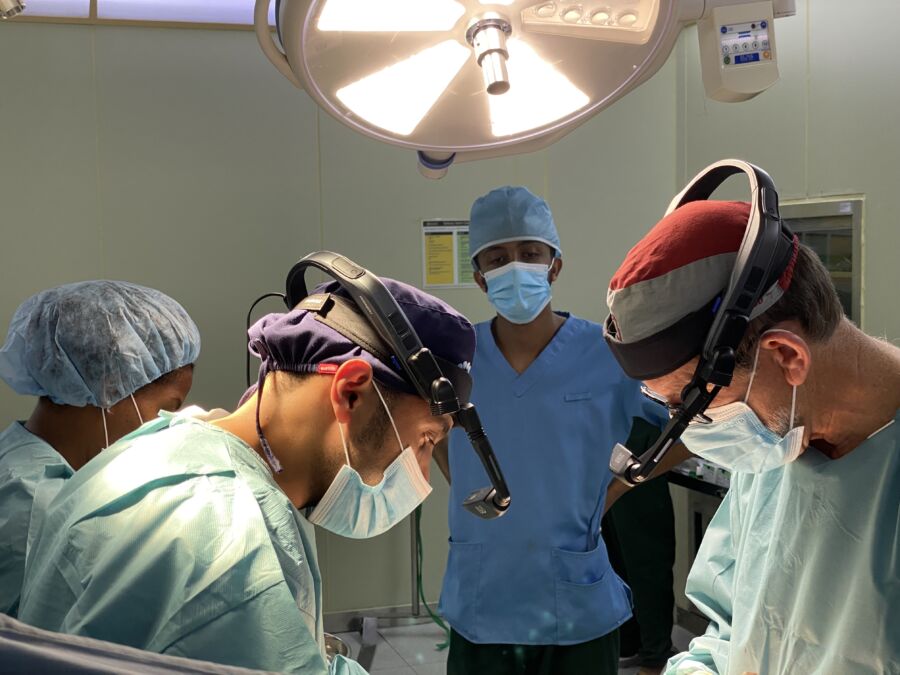When we spoke with Dr. Morten Kildal, Associate Professor and Consultant Plastic Surgeon at Uppsala University Hospital in Sweden, he had just finished his day educating surgical students to save lives – a pursuit he is now advancing in low- and middle-income countries with the aid of head-mounted voice- controlled cameras, allowing for hands-free operation, recording, and live streaming of video over wireless networks.
This innovative approach surpasses the limitations of fixed cameras, often obstructed by the surgeon’s movements and unable to follow their shifts in focus. However, the transition to a head-mounted camera introduces a new challenge: the viewer’s experience can be disrupted by the surgeon’s natural head movements – which can make it very difficult to view the raw video.
Vidhance for Remote Assistance, featuring the powerful Vidhance Premium Stabilization and Vidhance Click & Lock features, addresses this challenge head-on by seamlessly stabilizing the live video stream and offering remote viewers the ability to control zoom and camera focus. In doing so, Vidhance for Remote Assistance not only improves today’s limitations of head-mounted cameras but also contributes to the transformation of how surgical training is conducted.
The First Step to Surgical Success is Access
In low-resource settings, limited access to safe and affordable surgery is a pressing issue. Surprisingly, the lack of surgical access contributes to 17 million annual deaths, accounting for 33% of all deaths worldwide – 13.5 times more than malaria-related deaths.
Those figures come from a 2015 study in The Lancet, which also found that a full five billion people do not have access to safe and affordable surgery, with subsequent research from NIH further defining a lack of access for 1.7 billion children. According to Dr. Kildal, safe surgical burn treatment is often entirely unavailable in most areas outside of capitals in low-income countries in Africa.
According to Dr. Kildal the problem is multifaceted, but Vidhance for Remote Assistance software is helping solve one of the main challenges: training more surgeons and surgical teams.
“Access to surgery is particularly inadequate in low- and middle-income countries due to a lack of trained surgeons, proper facilities, tools and equipment combined with often unstable electrical power,” he explained. “There is an urgency to focus on the training of young surgeons and surgical teams to build the human capacity for safe surgery. Remote video communication has created an opportunity for us to create a better and more efficient real-time learning environment for a larger number of young doctors and nurses, but unlike many everyday needs, the quality and user control of the video must be virtually perfectly adapted to the needs of the surgical trainees and their teachers to be really useful.”
Specialized Technology for Specialized Needs
Dr. Kildal’s live, real-time scenarios pose technical challenges, including focus control, camera stability, and managing extreme contrast lighting during surgeries. The combination of the Vidhance Premium Video Stabilization feature, which makes frame-by-frame adjustments to stabilize and level video based on a camera’s motion sensors, and the Vidhance Click & Lock feature, which enables remote participants to lock the camera’s focus and zoom by clicking on an object or region in the live video, improves the user experience, according to Dr. Kildal.
“People today would likely think these obstacles have been overcome based on their personal experiences with rapidly advancing technologies, but this situation is highly specialized and requires purpose-built hardware and software developed in close collaboration with users to achieve reliably good performance,” he said. “Vidhance significantly improves the stability of video captured through head-worn cameras in the operating room and provides the ability for remote viewers or supervisors to click and lock to retain focus on specific areas even if they temporarily move out of the frame.”
The setup can work in both directions, with a young surgeon on-site being aided by an experienced surgeon in a different country, or with an on-site experienced surgeon hosting a training session with any number of surgical students viewing remotely.
“In addition to enabling high-quality recordings, an optimized video solution actually allows us to change the format of training sessions and move the students out of the surgical area, which quite often is better for the attending surgeon, the patient, and the students themselves,” he added. “In fact, the live broadcast capabilities can enable students and classes to follow two or three surgeries at the same time, have ongoing group discussions, re-watch recordings for further study and have the possibility of accessing relevant literature as surgery progresses.”
Advancing Global Surgical Access
Whether he is working with Doctors Without Borders, 2nd CHANCE, Operation Smile or his own Swedish Burn Care Foundation, Dr. Kildal is determined to increase surgical opportunities in places like Kenya, Rwanda and Ethiopia. He recognizes, however, that this technology is also useful and needed even in more advanced health care systems especially as they are widely predicted to face shortages of qualified professionals in the coming decades.
With the stabilization and control enhancements that comprise Vidhance for Remote Assistance, Vidhance technology is adding value and helping pave the path to a brighter future where more patients have access to qualified surgeons all over the world.





